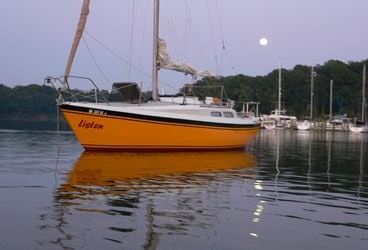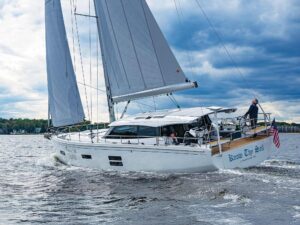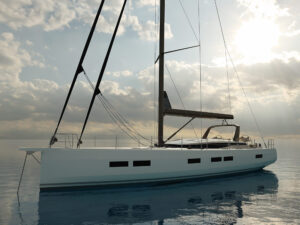
newport 27 368
Success came quickly to Capital Yachts of Harbor City, California, when it debuted the Newport 27 in 1971. The boat, designed by George Cuthbertson and George Cassian, the founders of C&C Yachts, quickly established itself on the local racing scene. The 27 was in production for about 15 years.
For a 27-footer, the boat has an unusually commodious interior. Standing headroom is just over 6 feet, and the most common interior layout features a V-berth, a head, and a small hanging locker forward of the main bulkhead. Settees measuring 6 feet in length run along either side of the saloon. Two people can sit comfortably on each settee at the table, which can be folded up flush with the bulkhead when not in use; under way, this surface serves as a nav station.
Aft of the settees, a small counter to port contains a sink and icebox access. Opposite is another counter with a recessed two-burner alcohol stove. Variations on this layout include a starboard quarter berth, a fixed dinette with raised seating fore and aft, and an aft-placed head. Regardless of the layout, oiled teak was used liberally, its warm traditional aesthetic spoiled somewhat by the adjacent wood-patterned Formica that covers all horizontal surfaces.
Construction is typical for the era and the price point. The hull is hand laid, and the keel is lead. All through-hulls are bronze, but they’re fitted with PVC gate valves. Dry storage seems endless, but tankage is inadequate for longer than a weekend cruise; the holding tank is only 6 gallons.
Tiller steering is standard, and the underbody features a fin keel and a balanced spade rudder. Early models draw a modest 4 foot 3 inches; the Mark II models have 5-foot-2-inch draft for improved upwind performance.
Displacing 6,000 pounds, either version scoots along in light air, but both are tender. As wind and boat speeds increase, so does weather helm. On my boat, a Mark II, an Autohelm 1000 tillerpilot could only manage so much weather helm, and I often reduced sail earlier than I might have otherwise done.
The traveler is forward of the companionway. Friction between the traveler and its track makes it difficult and dangerous to adjust it if the mainsheet is under any significant load. Installing a modern traveler should join replacing the PVC through-hull valves at the top of any improvements list.
Most Newport 27s came with an inboard auxiliary, either a gasoline-powered Atomic 4 or, later, an 11-horsepower Universal diesel. Access to the engine on either inboard version is excellent.
Used Newport 27s list between $10,000 and $18,000, depending on condition and the upgrades made. While not a stout offshore cruiser and no longer a competitive racer, the Newport 27 is still a capable, inexpensive daysailer that, when upgraded and outfitted accordingly, can deliver modest coastal cruising to a couple or a singlehander.
Specs
Newport 27
LOA 27′ 0″ (8.23 m.)
LWL 22′ 4″ (6.81 m.)
Beam 9′ 2″ (2.79 m.)
Draft (early/Mark II) 4′ 3″/5′ 2″ (1.30/1.57 m.)
Sail Area (100%) 360 sq. ft. (33.44 sq. m.)
Ballast 2,400 lb. (1,088 kg.)
Displacement 6,000 lb. (2,721 kg.)
Ballast/D .40
D/L 241
SA/D 17.4
Water 14 gal. (53 l.)
Fuel 19 gal. (72 l.)
Engine Atomic 4 (gas) or
Universal (diesel)
Designer Cuthbertson & Cassian
Michael Robertson and his wife sailed their Newport 27, Del Viento, from Ventura, California, to Florida via most of Central America. That was in 1996 and 1997. They plan to go cruising again soon, with their two young daughters.








